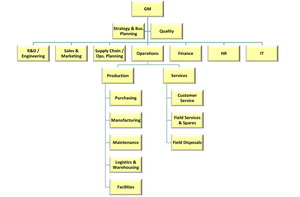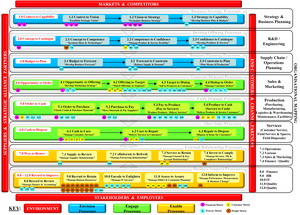Organisation Model Layer
As we move along the business architecture routemap we arrive at the organisation model step. In this model the topics of (top-level) organisational design and the locations of facilities infrastructure are examined. As is the case with other aspects of architecting they will be refined and extended in more depth (e.g. role descriptions, RASCI matrix, pay & reward, etc) in later stages of the business transformation roadmap.
From an organisational design point of view, given our the 80/20 style of approach, we will just put forward a simple tried and tested top-level organisational design as per the figure below (click on it to see an enlarged version in a new window).
We know that the above is not highly innovative or rocket science. We also know that organisations love to tinker endlessly with these designs and will change anything we put forward to suit themselves anyway……so why fight it.
One thing always fascinates us however, and that is the fact that many organisational designs we have seen over the years, if you just change the quirky and high-powered labels that sometimes get stuck onto them, are in fact quite closely in keeping with some variation on the above design…..go figure!
 A very salient point that is sometime made to us about the crusty old design above is that it is an ‘old fashioned’ functional silo design….when we are talking about processes here…..so what gives? Well, in truth we are aware of this, but we have yet to see anyone, what-ever the level of lip-service they pay, implement a true process organisation structure at board or very senior management levels.
A very salient point that is sometime made to us about the crusty old design above is that it is an ‘old fashioned’ functional silo design….when we are talking about processes here…..so what gives? Well, in truth we are aware of this, but we have yet to see anyone, what-ever the level of lip-service they pay, implement a true process organisation structure at board or very senior management levels.
Perhaps because there is little or no track record of this at the top of organisations, and that old habits die hard, explains why there is little appetite for non-functional designs in the boardroom.
All we can tell you is that most organisations, even those busily implementing processes lower down in their operational spaces, usually loose their nerve at the top and glue a functional management structure onto their process model in a sort of matrix structure in which the functional side still retains most of the ‘real’ power. You can fight the boardroom execs if you want to, but we are sticking here with what we know will work and be accepted.
Consequently, the above organisational design when glued onto our combined process and performance model, looks thus (click on it to see an enlarged version in a new window).
We will leave it to the reader to imagine what might be possible in their own organisation and draw it up accordingly in their own business architecture organisation model!
Now, onto the other topic of this blueprinting layer, that of facilities infrastructure. We have just been talking about an organisational design, well those folks will need to sit and work somewhere, and that is the topic of this aspect of the organisation model.
Clearly, if you have only a single location, and don’t plan to move as part of your business transformation initiative, apart from perhaps adding a bit of space there is not a lot you need to do here. However, other organisations may have many locations, perhaps accumulated through acquisitions…….with sales, service, production and distribution facilities all around the globe.
In this latter type of organisation a business transformation initiative is a golden opportunity to consolidate and optimise that network of global facilities…..opening new, closing old and merging those with strong overlaps. To decide on what the optimal facilities network is in these circumstances usually involves considering variables such as customer and supplier proximity, distance and cost to move materials and finished goods, ability to meet delivery slot promises and service level agreements, etc.
 Finding the right balance or centre of gravity for this sort of global operation is no trivial matter and is often accomplished via sophisticated business simulation and modelling tools operated by professionals who specialise in this sort of activity. In any event the particulars are beyond the scope of this website.
Finding the right balance or centre of gravity for this sort of global operation is no trivial matter and is often accomplished via sophisticated business simulation and modelling tools operated by professionals who specialise in this sort of activity. In any event the particulars are beyond the scope of this website.
But, however you accomplish it, through means simple or complex, what is required now for this part of the organisation model is a tentative (yes, potentially subject to confirmation by more detailed work later) list of locations and the purpose(s) for which they will likely be used…..which of course will also enable you to consider the implications related to those new, merged and closed locations.
Such a high-level facilities infrastructure location map might look as that depicted in the figure below (click on it to see an enlarged version in a new window).
Once you have the facilities infrastructure location map as depicted above, plus a few additional rough-cut estimates such as relates to purpose(s) and sizing, we’re sure you can imagine how it will be developed further in later stages of the business transformation roadmap.
As roles, skills, physical assets and ultimately people are mapped onto the activities planned for each location!
 If the content of this webpage makes you feel that being a member of our Biz4ge Network, or a Certified Affiliate within it, would be of benefit to you please Contact Us and we will get in touch by return. Your contact will be treated as confidential and will be at no cost or obligation to you.
If the content of this webpage makes you feel that being a member of our Biz4ge Network, or a Certified Affiliate within it, would be of benefit to you please Contact Us and we will get in touch by return. Your contact will be treated as confidential and will be at no cost or obligation to you.



